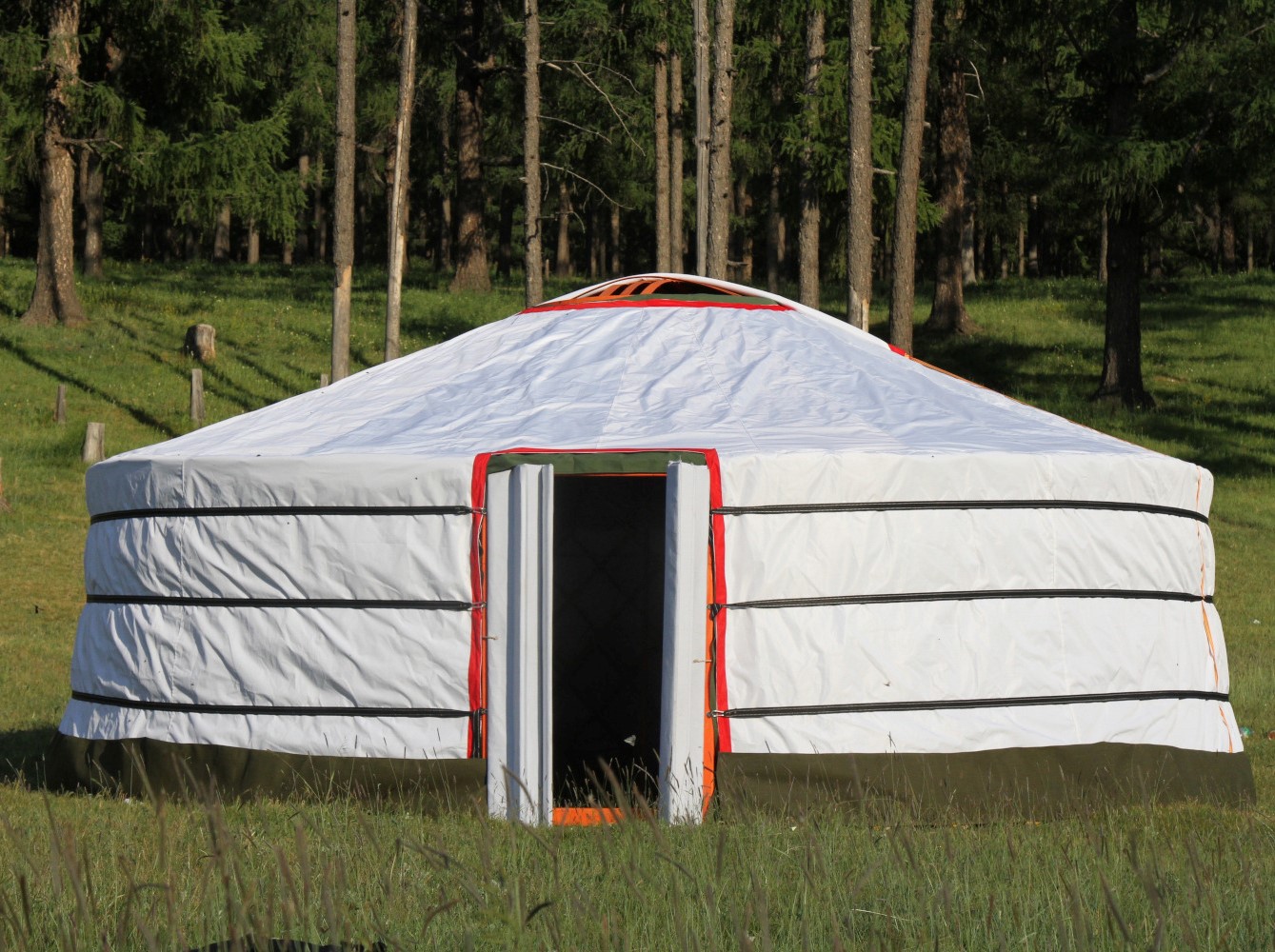Mongolian ger
Mongolian ger originated and inherited from the ancient nomads,including Hünnü people. This is a portable structure that is easy to dismantle and erect and light to transport. There is good air-circulation and very good lighting by the sun. It is possible to get an orientation of a time according the increase or decrease of the sunlight in ger. The frame-wood of Mongol ger consists of crown-frame, spokes, trellised walls, door and pillars, and its covering also consists of crown-cover, roof-cover, under-cover of roof-cover, wall cover and door-felt or wooden door. The ger can be divided into various shapes such as quadric-sectioned, pentagram-sectioned, hexagonal and so on. In the ger, the space can be sectioned. The north is honourable and equal to the eastern and western sides, the hearth and the door area. The ger was pitched on the cart and carried by the many oxen in ancient times. This was called a ger -cart. It was a palace for the Mongol kings and queens. The ger -cart was very popular in twelfth and thirteenth centuries.
Trivet
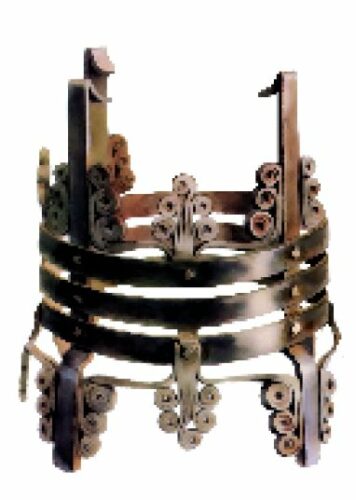 The trivet is used for warming the ger and cooking over a fire in the ger. It was customary from ancient time. Trivets are divided into various types as mere-trivet, portable-basket-trivet and so on. It is placed in the centre of the mere-trivet is made of the three legs or three projections with brackets. The bases of the projections are splayed.
The trivet is used for warming the ger and cooking over a fire in the ger. It was customary from ancient time. Trivets are divided into various types as mere-trivet, portable-basket-trivet and so on. It is placed in the centre of the mere-trivet is made of the three legs or three projections with brackets. The bases of the projections are splayed.
The trivet is a sacred item for hearth. So, the Mongolians vener ate the trivet as a sacred element based on the hearth of place it on the most important thing when they move to pasture land. It is taboo to put and burn the litter in the hearth in the trivet. There is a view that the fire-god might get into a if you put the litter in the fire. It is also a taboo to pour water on fire in the trivet. If it has happened, the hearth will go to its If it becomes necessity we say to the fire-god, “Please take off your legs.” Then we extinguish the fire and a trivet should definitely be left to cool off on its own.
Bridle
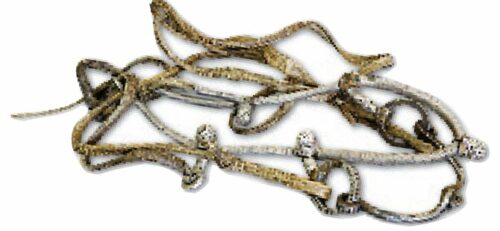 The bridle is very important for riding a horse. The bridles are identified as single, double, and silver-topped bridles. The bridle consists of a bit, head piece, nose-band cheek-piece, brow-band, throat-strap, and reins. One should not enter a ger by tucking the bridle and halter in one’s belt or sash. There was a custom for a person who intended to arrest somebody to enter a ger by tucking his bridle and halter in a belt. Because of this, it became a taboo.
The bridle is very important for riding a horse. The bridles are identified as single, double, and silver-topped bridles. The bridle consists of a bit, head piece, nose-band cheek-piece, brow-band, throat-strap, and reins. One should not enter a ger by tucking the bridle and halter in one’s belt or sash. There was a custom for a person who intended to arrest somebody to enter a ger by tucking his bridle and halter in a belt. Because of this, it became a taboo.
Halter
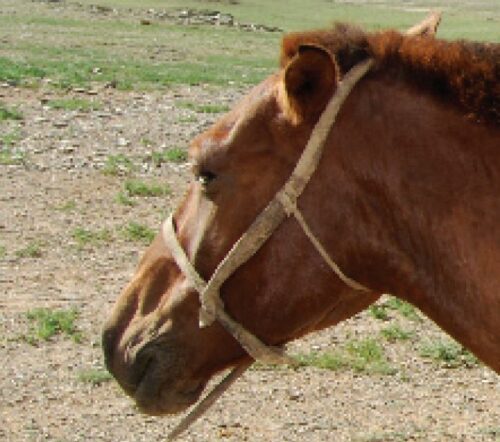
The halter is important to lead animals or hitch them to the posts. The halters are made of leather and hairs and are classified as foal’s, baby camel’s, horse’s or camel’s halters. It consists of nose-band, throat-strap and leader (throat-lash).
Whips
he whips are used for striking animals and are classified as swift-horse’s, horse-catcher’s and festival’s. The whips are identified as cane, cornelian, willow, and sandal whips by the materials out of which they are made. By the size, whips are called as long, middle, short and child’s whips.
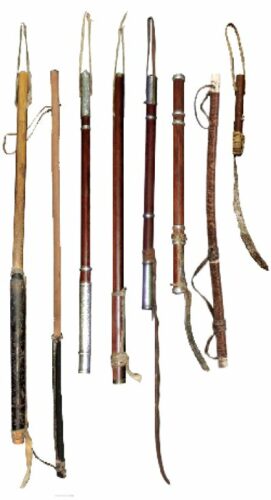 The length of the whip for swift horse is 20-25 cm. It has a leather loop to hold its end and hide lash which is 510 cm. The longest whip is made of rattan, cane and cornelian, Chinese pine, tamarisk and honey-suckle. The length of it is 90 cm and its holstered section is 12 cm. Its lash is 40 cm. The rattan whip is considered a favourable thing for the Mongolians. The stock of the Chinese pine whip is a span or span plus a half span; there is even a four-finger sized Chinese pine whip. We make a Mongolian type of quirt which is braided hide riding whip. The whip used for horse catcher is made of willow. The willow whip is light and doesn’t hurt the riding horse. The size of the willow whip is the same with the leather whip. The whip for the swift horse is made of only tamarisk. The size of tamarisk whip is narrow. The length is from span to cubit. There is tradition to swap good whips among the close friends. This is taboo to point at somebody by whip, to strike a horse’s head with whip or enter ger holding a whip.
The length of the whip for swift horse is 20-25 cm. It has a leather loop to hold its end and hide lash which is 510 cm. The longest whip is made of rattan, cane and cornelian, Chinese pine, tamarisk and honey-suckle. The length of it is 90 cm and its holstered section is 12 cm. Its lash is 40 cm. The rattan whip is considered a favourable thing for the Mongolians. The stock of the Chinese pine whip is a span or span plus a half span; there is even a four-finger sized Chinese pine whip. We make a Mongolian type of quirt which is braided hide riding whip. The whip used for horse catcher is made of willow. The willow whip is light and doesn’t hurt the riding horse. The size of the willow whip is the same with the leather whip. The whip for the swift horse is made of only tamarisk. The size of tamarisk whip is narrow. The length is from span to cubit. There is tradition to swap good whips among the close friends. This is taboo to point at somebody by whip, to strike a horse’s head with whip or enter ger holding a whip.
Tri-hobble
The tri-hobble is one of the tackles for riding horses. The tri-hobble is made of simple or double leather or hair (twined or three stranded). The tri-hobble consists of two prongs and shaft, one of the prong consist of it flat-strap, loop and pin (toggle). The pin of the tri-hobble is made of only tamarisk or birch. It is a taboo to reverse hobbling horse. In another word, it is taboo to tri-hobble two hind legs and one fore-leg of horse. There are many forbiddances concerning the tri-hobble.
 Horse cart
Horse cart
This cart is two wheeled transport vehicle used for farm purposes and for conveying heavy loads. By its mate-
rial carts are called as larch or birch cart, by its made, cart is called as the cart with compositor rimmed or cart with circular rimmed wheels. The cart consists of an axel, spoke, fell or rim and frame. The two wheeled horse cart is furnished with a cabin in which passengers sit and travel. It is also furnished with a barn in which we store materials and can be turned into carriage. The enclosed seat of the cart is furnished with two poles and carried by two persons.
The harness of the horse cart
The harness consists of the collar, crupper, saddle, girth and shafts. The collar consists of felt padded wooden band to fasten shafts and to affix straps. The wooden bars of the collar can help to make the trace tight or loose if the axle of the horse is on the level to the middle of the wooden bar. The crupper can regulate the weight of load on the up or down slopes of the land. The average length of crupper is 3-4 m. If the crupper is too short, it can chafe the dock of tail. The saddle of the horse cart consists of pair of birch bars and bow, girth and slot of strap. The saddle is padded with felt and fixed to the cushion buckle. The straps of the cushion are furnished with loops and attached to the shafts.The pad saddle has birch bows and its bars are padded with felt. There is a piece of iron through which the girth can pass and be fixed. There are two kinds of pad saddles. They depend upon the shape of horse’s back. One is flat, another is circular. The girth can regulate the weight of load.
Oxcart
Our ancestors invented a way to harness an ox to a wagon. The history of the ox-cart is old. There are over 70 cart drawings on the rock arts of ancient origin in Mongolia. The majority of them are oxcart drawings. The oxcart is composed of yoke, crupper, pad-saddle and strap securing the shafts to the pad-saddle. The role of the yoke is to join the two shafts of the cart and two ends of the throat strap. The yoke made of birch is curved slightly. The length of the yoke is 60 cm; the two holes in row at the two ends of yoke are drilled. There are four holes at the two ends of yoke. They are connected to the two shafts of the cart. The role of crupper is to regulate the weight of load on the cart. The crupper is made of hair rope.
The role of the pad-saddle is to lift the shafts of the cart, to regulate the weight of the load on the cart and not to chafe the ox-back. The pad-saddle is padded with felt. The role of the strap is to secure the pad-saddle and pull the shafts of cart. The wheels of the oxcart do not revolve on its axis, but they are made of single wood and consist of four sections of felloes. But the wheels of horse-cart revolve on its axis.
Saddle-rug
Saddle rug is similar to the horse-saddle; it consists of the flaps like horse-saddle’s sweat flaps. The saddle rug is made of the quilted felt or rug. It is sometimes made of the leather. The two flaps are connected with shagreen, leather or felt. The saddle-rug consists of a loop for hump, cushion, stirrup, girth and slotted strap. There is a sweet-cloth under the saddle-rug. The length of gelding camel’s saddle-rug flap is 65cm, width of the saddle-rug’s seat is 40cm. the width of the saddle-rug’s thickness is 30cm. The sweatcloth can prevent chafing of the camel’s back. The loop for hump can prevent a saddle-rug to move forward or back. The cushion gives comfort to ride a camel. The saddle-rug has only one girth.
Tools to load a pack-camel
This tool is designed to relieve the weight of load. It is called khom, which is composed of two pieces of quilted felt-rug, two bars to clasp the felt-rugs. The bar consists of two parts. The bars are made of larch or birch trees. The length of bar is 1.2-1.5 m, thickness of bar is 6 cm. There is felt-wrapping, which wraps the two humps and prevents the chafing of humps. The wrapping is soft felt called bambai which is made of quilted felt. There are two types of swifter which used tighten or keep a load in its place. The big swifter (ikh tatlaga) is over 10 fathoms (they are made of leather, hemp and hair) lesser swifter (khom tatlaga) is 6-7 fathoms.
Comb
This is a tool to comb hair. The comb is a necessary thing for Mongolian women who carry it tucked into the sash of their deel. It was a custom. When Mongolian women go out, they have to comb their hair and form them into long lock in any cases. If they did not do this, it was considered a failure in life. In ancient times it is forbidden to go out of ger with one’s hair hanging loosely or without combing one’s hair. Doing so was a sign of widow. Combs are made of wood, bamboo and horn. Mongolian women used silver cased combs inlayed with pearls, turquoise or garnet. There were also silver combs or combs inlayed with silver.
Tooth Comb
This was very important thing to clean the hair. Tooth comb is made of bamboo. Mongolian women used variety of tooth combs and did not borrow them to people for hygienic reasons.
Scratcher
Most elder people had bamboo scratchers and used them to massage their rheumatism of their shoulders. They think that if they are scratched by children, children can get rheumatism from scratching. So they use bamboo scratches.
Airag-skin
This vessel is made of hide for holding airag, clotted milk and fermented beverage. The skin consists of mouth (orifice), neck, kharaa (a bar wood on which the neck of airag-skin is fixed, the decorated piece of bar is attached to a special slat) corner, body and cords. First we remove hide’s filament; then we dehydrate it in the wind. Then we fumigate it; in such a manner it becomes white leather. We double and cut the white leather and turn the surface of white leather into the inside and place narrow strip of cloth between two leathers and piece together. The three pieces are stitched. In such a manner airag -skin is made. Airagskin can hold 40-100 liters of milk beverage. The mare’s milk is fermented. We add some yeast to the milk and produce airag which is the fermented liquor from mare’s milk.
Paddle
Airag-skin needs paddle and wooden cask. The paddle plays important role in fermenting airag and khoormog (milk beverage of mare-camel). The paddle is long-handled which is furnished with bored blade of board or bored spoon shaped blade of root. There is a portable paddle which can be assembled or dismantled. The bored paddle can stir the milk of animal and crush globe-shaped ghee (clarified butter). This accelerates the fermentation and refines the beverage. The stirring of airag and khoormog is very ancient method of the Mongolians who used the decomposition process of organic substance for their life.
A stirrup is an implement of iron whose flat bottom hangs with stirrup straps on both sides of a saddle. The stirrups can help to lift you to mount a horse. The invention of stirrups by the nomadic Mongolians is the contribution to the world tangible culture. They are classified as ordinary, festivals, swift horse’s and child’s irons. The stirrups are attached to the both sides of the saddle tree. The stirrup is attached to the saddle by girt strap and slot of a buckle which has a length of 55 cm and width of 3-4 cm. The stirrup can be lengthened or shortened by the girth strap and slot of the buckle. The peacock stirrups are fitted for a camel’s rug saddle, and the strap of the stirrup is made of strap with a buckle. There is a tab between the cushion and rug-saddle through which saddle strap can pass and strengthen the stirrup. If the tread of iron is broad, you can feel comfortable for far journey. Length of the stirrup of Mongolian saddle is 40 cm, it is more comfortable.
Quern/Stone Hand Mill
There were horse mill, wind-mill and water-mill. They grind grain. The simplest mill was quern, which is a portable mill. The weight of it is 15-20 kg. The diameter of it is 35-40 cm. it consists of two pieces of round grind-stones. The thickness of grind-stones is 10-15 cm, the nether stone is immovable. There is a mill-eye on the centre of the nether. A wooden pin is fixed in the mill-eye. The runner, which is also punched out in the centre moves upon the immovable nether stone. The mill-stone is furnished with circular grooves which grinds grain to powder or flour. There is also receptacle brim of the runner which receives a stick. The length of the stick 15-20 cm, the runner is moved by this stick. The wheat and barley are fried in the iron cast pot. The fried wheat or barley are pestled in a mortar. They are separated from their chaffs. Then they are milled into wheat or barley flour. The mill-stone is respected by Mongolians. It is a taboo to sit on the mill-stone. They believe that the heaven might get in a rage if you sit on the mill-stone. It is forbidden to move the mill-stone anti-clockwise. It is believed that if you move it anti-clockwise, you can be giddy.
Wooden vice
This wooden vice is used for gelding horse or camel colts. The scrotums of horse and camel colts are cut and the testicles are gripped in wooden vice; the wounds are scorched by searing iron. So we say horse colt searing or camel colt searing. In order to geld the colts, we drop a dollop of milk on the wooden vice. The searing iron is furnished with honorary scarf. After gelding,the wooden vice and searing iron are held in high esteem and stored in safe place.
Neb
This is a tool to stop sucking. During the lambing season tegs and heberlings start sucking their mothers. So put this kind of neb on their muzzles to prevent their sucking.
Ski
Tis a rock drawing of a person on skis (Tsagaan salaa Bayan-Ölgii province). There are notes written by Rashid Al’ Addin and G. Roubruck about the Mongols sliding as if they were flying on the snow and ice. At present Uriankhai hunters and reindeer people make skis by hewing and thinning birch tree and gluing skin of ovis ammon) or ibex on the under-part of ski. The ski has two sticks. The one of sticks is spade shaped.
Vanity-bag
There was custom to carry vanity-bag which is tucked in the Mongolian lady’s sash or “belt”. This bag contains tweezers, ear-pick, tooth-pick, nail-cleaner and small bottle of perfume or comb.
Comb
This is a tool to comb hair. The comb is a necessary thing for Mongolian women who carry it tucked into the sash of their deel. It was a custom. When Mongolian women go out, they have to comb their hair and form them into long lock in any cases. If they did not do this, it was considered a failure in life. In ancient times it is forbidden to go out of ger with one’s hair hanging loosely or without combing one’s hair. Doing so was a sign of widow. Combs are made of wood, bamboo and horn. Mongolian women used silver cased combs inlayed with pearls, turquoise or garnet. There were also silver combs or combs inlayed with silver.
Tooth comb
This was very important thing to clean the hair. Tooth comb is made of bamboo. Mongolian women used variety of tooth combs and did not borrow them to people for hygienic reasons.
Scratcher
Most elder people had bamboo scratchers and used them to massage their rheumatism of their shoulders. They think that if they are scratched by children, children can get rheumatism from scratching. So they use bamboo scratches.
Pail for milking
This is a vessel to milk used only for milking. So it bears such name. The size varies between big, medium and small. It has three girdles (girdle is made of brass, iron,silver and cork). The handle is furnished with punched stone, bronze-arrow or figure of horse. It is an ancient custom. The local people of Khövsgöl province symbolize animal milk as the water of Khövsgöl Lake and hang a punched stone of the lake from their pails for milking. It is completely forbidden to pour any thing except of milk into a pail of milk. It is forbidden to pour sable water into a pail for
milk. It is taboo to place pail for milk near thedirty things. If water can be poured into the pail for milk as necessity, in that case seven white grits should be placed in the pail for milking.
Small table
The small table with flat top and propped up by four strong legs is very popular inongolia. There are many types of such tables. But this small table is fitted in Mongol ger. This is oblong and bow-legged table. Its height is one (ell). This table can made of any kind of wood.In an ancient epic there is an episode:Red sandal wood table with elephant-legs.This kind of table is made based on a myth that the world was existing on the back of four elephants. So the myths and legends help to study the origin and shape of things.
Cask for Milk-Skim
Hollow round wooden vessel to store milk-skim and cream is called örömnii khavchig . This cask is mostly oblong. The size of it is various. The biggest is palm. The smallest is span and two fingers. It has three hoops and a lid. Cask for milk-skim is made of the buck thorn tree or elm. The livestock breeders collect milk-skim and cream in a wooden cask during summer and render these in autumn; they produce ghee and rendered cream. This is one of the important vessels. We place only milk-skim and cream in the vessel.
Tankard
This vessel is made of brass, copper, silver and others to contain tea. It has two types: spouted or spotless. There is a gilded tankard. The wooden tankard is made of staves of Chinese elm or birch and bound it with three hoops. The height pine, buck thorn tree, sandalwood of tankard is about one ell. The wooden tankard keeps tea warm. It is very suitable for Mongolian condition. The largest is called a horse-tankard. Our artisans devise various methods to make a tankard. There are many legends about them. For example: Sanjaa craftsman, made a tankard which produced the sound of plopping when the tankard with tea was tilting to one side.
Hide flask
This vessel is narrow necked and saddle-shouldered for holding , clotted milk, milk vodka, wine and bot tom is even. It can hold 1-2 liters of liquid. In order to make a hide flask, it is necessary to dress, stitch, stamp, and apply a polish. This is a kind of crafting. Its stopper is made of birch, aspen or poplar. A well made flask can hold liquid for long time. It does not get soaked or loose its shape.
Cup
This is a drinking vessel, which is mostly spherical. It can be divided into big, middle, small and medium dimensions. The cup is made of wood, stone, bronze, brass, copper,gold and silver. A wooden cup is called elm cup, birch cup,cedar cup and root cup. By their purpose and shape, cups areidentified as bowl for alms, skull cup, shallow cup of root,big bowl, small bowl and cup for good fortune. Cups of gold,silver and copper can be used for the honorary guests. Cup for good fortune is used for rituals or invoking good fortune.Bowl for alms can be used for begging for food and alms, and for drinking milk-beverage. A bowl for airag, a medium bowl, and a big bowl are cup-shaped vessels. A skull cup is used for sprinkling vodka. A broad-mouthed cup is called delbeg; a deep hollowed cup is called mandal; a hollowed wooden cup is called saval small shallow bottomed cup is called ; a deep bottomed cup is tujraga; a cup-shaped cup is; and a nearly hemispherical basin is bowl). A narrow brimmed, shallow bottomed cup with thickness in the middle is tsovkhor There was a custom for every Mongolian to carry a cup in a pouch with oneself; the pouch was tucked in one’s belt or sash. The pleated pouch was called saadag alchuur Silver cased cup is masterpiece of Mongolian silver-smith. It demonstrates the exquisite workmanship both to make vessels of gold and silver. These masterpieces are the pride of Mongolian people. It is forbidden to exchange cups with each other. There was a custom for everybody to carry a pouched or pocket edtradition from the hygienic point of view. According to thecup when they went out of their own home. It was very good Mongolian tradition, we do not treat our guests or visitor with cup which is chipped or cracked. If you do, it is a sign of non-respect. It is taboo to invert a cup. If you invert a cup, it is a sign of losing your fortune. It is also taboo to break a cup intentionally, but we do not blame a child who has broken a cup. It is unacceptable not to taste a tea which is offered from a host. There is belief that if you do not taste, the devil can taste instead of you. It is also taboo to offer a tea by pressing the brim of cup with one’s finger. If you press the brim of cup with your finger, it was a sign to arrest somebody. There are many decorous behaviours concerning cups.

